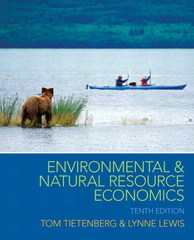I need guidance with exercise 4,5,6,7.
1You have been hired by an allinclusive day spa (with no overnight accommodations), frequented by wealthy guests who make an average of $100,000 per year. One ofthe premier attractions ofthe spa is a hike to a waterfall and scenic overlook. Guests currently take an average of 2 hours, round trip, to visit this site. In addition to this hike, the guest can enjoy other activities such as apool, hot tub, sauna, etc., all included in the price of the visit. Guests spend an average of 8 hours per visit. The spa is considering buying some new [and and improving the hiking trail which would shorten the roundtrip visit to 1.5 hours, leaving more time for the enjoyment ofthe other amenities. The spa has asked you to estimate how much more it could charge its guests if were to make this investment. You decide to model the enjoyment of the guests using the CobbDouglas utility function, U = qmz, where q is the environment amenity of the visiting the waterfall and z is participation in the other activities. You estimate that 11:03.5 and [3:085 (notice that u+B=l- Since the resort is allinclusive, time is the only cost ofan activity and can be valued using the wage as the opportunity cost of time. An individual who makes $100,000I per year earns approximatety $50 per hour, so the total opportunity cost \"budget," M for an 8 hour visit is $400. The current price ofthe visit to the waterfall, p\".;, is $100 (because it takes 2 hours}. lfthe spa made the new trail, the price would drop to p1q=$?5 (because the hike would take 1.5 hours). The price ofthe other activities, m, can he treated as a numeraire and set equal to 1 hour of activity, or $50. 1. Set up the consumer maximization prohkm as a m and solve for the Marshallian demand curve for both the environmental amenity, q, and the other activity, 2. On average, how many visits will guests take to the waterfall at current prices? How many hours will guest spend in other activities? 2. Substitute your Nlarshallian demand curves back into your utility function, U{g,), to solve for the indirect utility function WW- How much utility, in \"utils,\" do guests currently enjoy from a visit to this day spa? 3. [avert the indirect utility function to obtain the expenditure function. That is, solve the indirect utility flmction, Um, for the expenditure function, EM. What expenditure do you get if you plug in the utility 'om part 2 and the original prices, pugpj? Does this result make sense? 1Why? 4. Using your Marshallian demand curve from part 1, intimate the change in Consumer Surplus each Eyests would obtain ifthe price ofenvironmental amenity were to be reduced om $100 (a 2 hour trip) to $?5 (a 5 hour trip). (Note: this will require that you take the integral ofthe Marshallian demand curve. The integral I grip = a - En(p). 5. Using your expenditure function, solve for the Compensating Variation if the price of environmental amenity were to be reduced from $100 (a 2 hour trip) to $?5 (a 1.5 hour trip}? 6. Which ofyour two measures ofthe willingness to pay is the better one to use? 1Why? What is the consequence of using the measure that is not the better one? 7. How would you explain your results to your day spa clients? Hovl.T much more would guests be willing to pay if the spa was to make this investment







